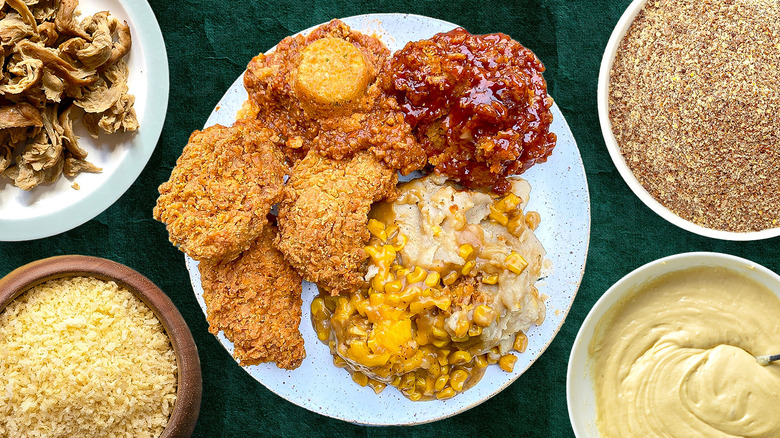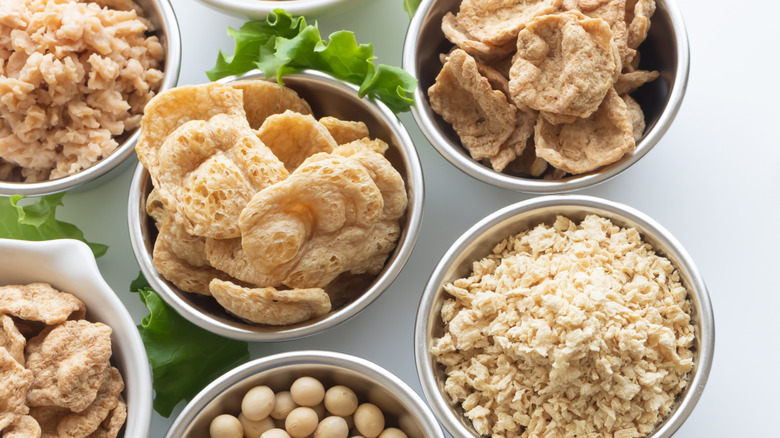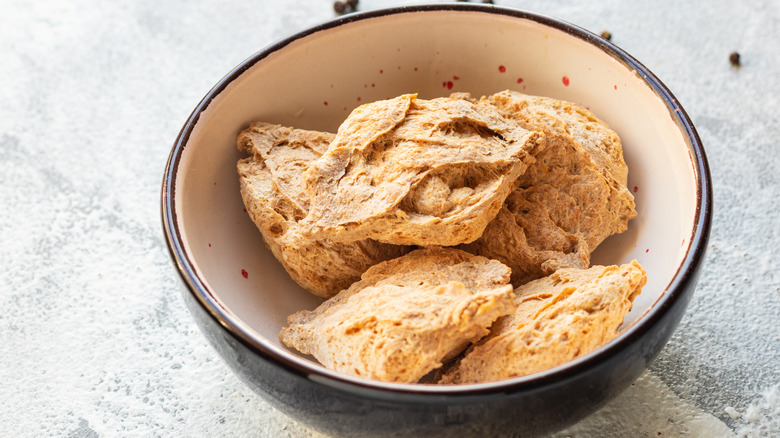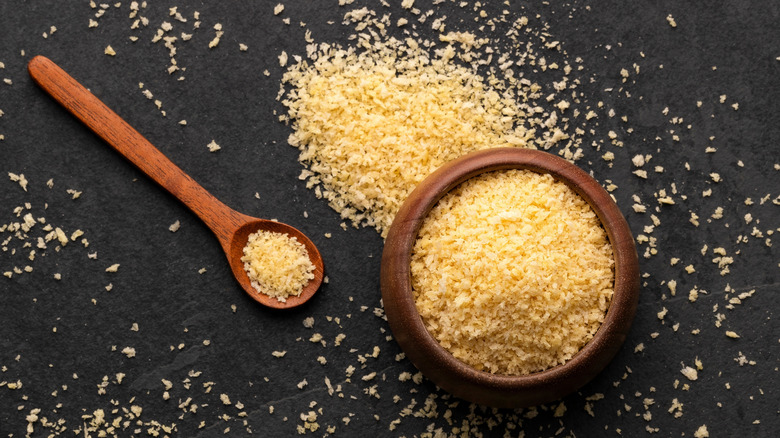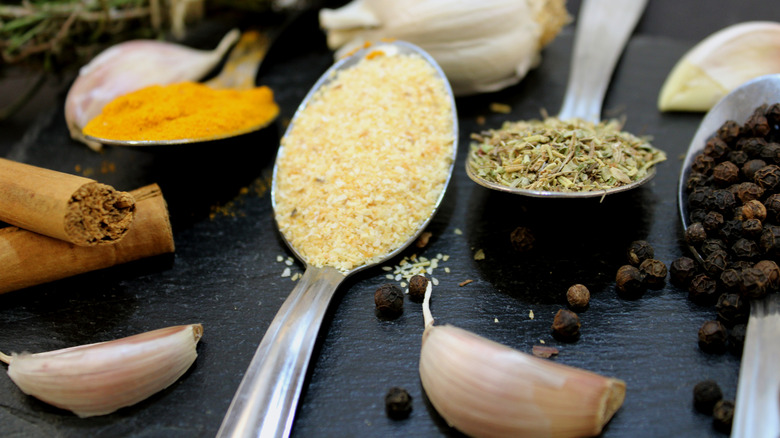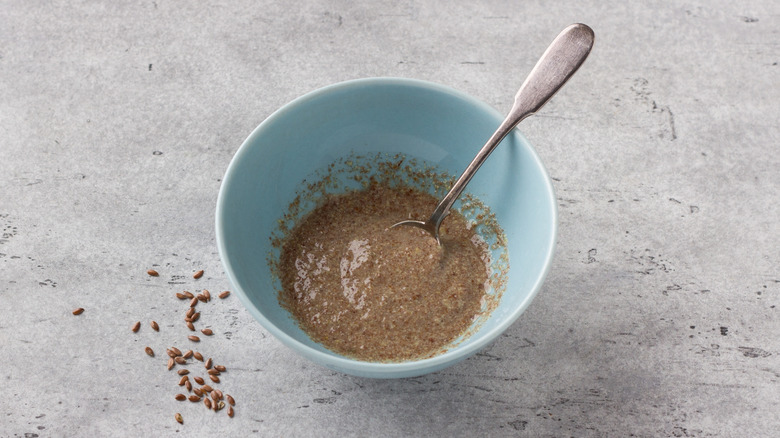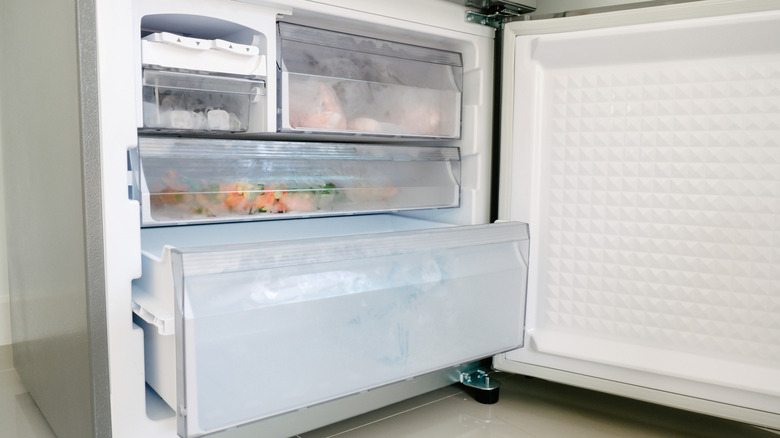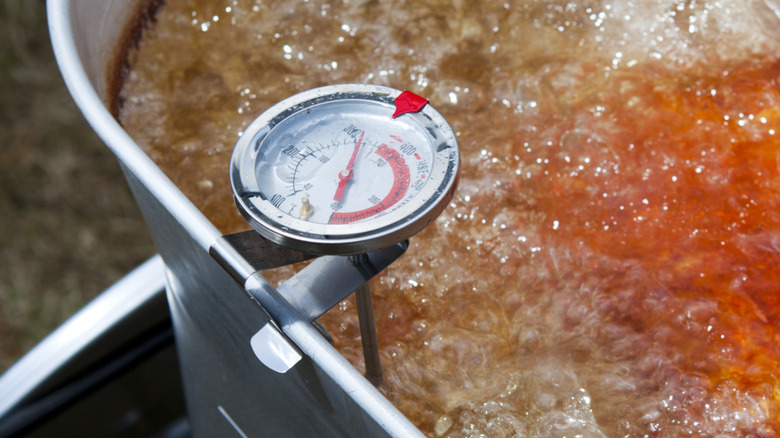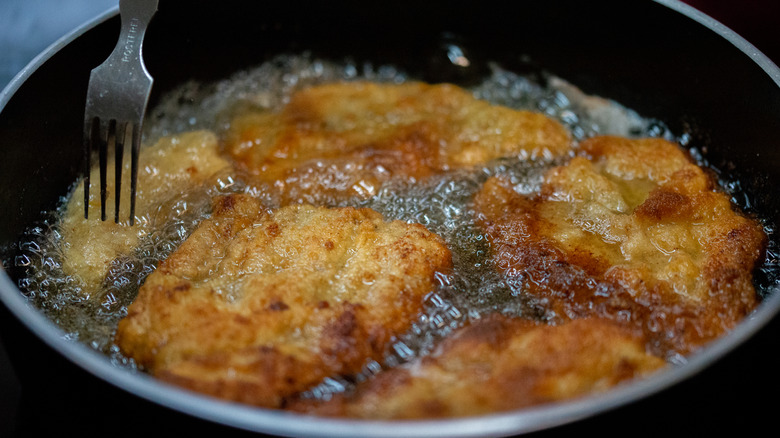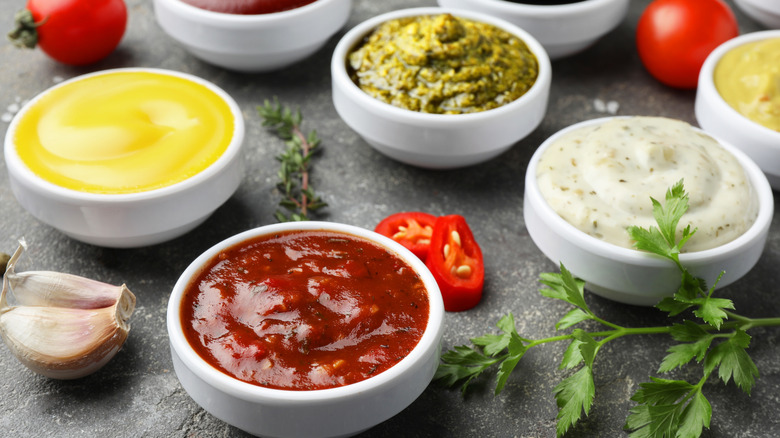10 Tips To Cook The Perfect Vegan Fried Chicken
Irresistibly crunchy on the outside and beautifully moist and juicy on the inside, the texture and flavor combinations that characterize fried chicken are pretty hard to beat. However, it turns out chicken is not a crucial part of the equation. Alongside the continued rise in popularity of plant-based diets comes the continuing rise of plant-based alternatives to comfort food favorites, with many vegan substitutes rivaling or even outshining their more classic meat-based counterparts. The best part of fried chicken is arguably its crunchy golden brown coating, and it's just as easy to recreate with plant-based proteins. Add to this the myriad delicious and versatile vegan-friendly substitutes for meat, and you'll see how easy it can be to make next-level vegan fried "chicken" with just as much crunch, flavor, and overall satisfaction.
For expert input on how to ensure your vegan fried "chicken" is the best it can be, we spoke to chef Trisha Gordon, an experienced professional cook and vegan recipe developer with a blog dedicated to plant-based recipes. Gordon's invaluable insight into how to ensure optimal results, from picking the right meat substitute to nailing your seasonings, dredging process, and cooking methods, provide all you need to know for guaranteed delicious vegan fried chicken.
Pick the right chicken substitute
A key part of ensuring excellent vegan fried chicken is selecting the right chicken substitute. The landscape of plant-based proteins is extensive, and as Gordon points out, "There are different options available to suit different diets at requirements." Popular choices as the base for vegan fried chicken include mushrooms, tofu, and cauliflower, each of which lend their own unique taste and texture to the dish. For example, cauliflower has a sturdy texture that holds up well during cooking, ensuring a satisfying bite and crisp exterior, whilst mushrooms boast a juicy and slightly chewy interior that provides a similar mouthfeel to chicken. Tofu, meanwhile, serves as a good choice thanks to its versatility, meaning it can be customized with any spices or flavor combinations you desire.
The choice therefore often comes down to exactly what you want to achieve with your vegan fried chicken, in terms of both taste and texture. According to Gordon, seitan is the best all-rounder. Made from vital wheat gluten, seitan's unique structure and slightly elastic quality makes it excellent for "foods with a meaty texture in vegan cooking." When used as a substitute for meat in fried chicken, seitan produces a satisfying and tender bite. It also develops a crunchy outside very well, helped by the ease with which coatings stick to it during the dredging process.
Consider making your own seitan
While you can buy it ready-made from the store, making your own seitan can take your vegan fried chicken to the next level. The ease of control and customizability that comes with making your own seitan makes obtaining the exact taste and texture you're after far easier. Making your own dough from scratch also means that you can season and flavor it however you want — Gordon says she tends to include nutritional yeast, onion powder, and garlic powder in her dough. Marinading and seasoning store-bought seitan (or any other vegan protein you might be using) will still ensure flavor-packed fried "chicken," but incorporating your desired herbs and spices at this stage will result in even more depth of flavor.
Since seitan is a relatively simple dough, made by mixing together vital wheat gluten with other fibrous ingredients like legumes, beans, and various seasonings or optional extras, making it yourself does not require too much effort. You simply need to combine your ingredients, and knead and rest your dough like you would when making a load, giving time for the gluten to do its job and ensure optimal texture. Though a little more time-consuming than using a store-bought variation, making your own dough if you have the time is an excellent choice if you want to maintain control, avoid excess additives or preservatives, or simply prefer making things from scratch for a fresher homemade feel.
Choose a breadcrumb with more texture
The coating is arguably just as important as the interior texture of any good fried chicken. So much of the indulgence of fried food comes from that delightful crispy golden brown exterior, and the right breadcrumbs can make all the difference. Whilst you may not give much thought to the type of breadcrumb you use to coat your "chicken," there are significant differences between varieties of breadcrumbs, so don't just use the first type you see. Try to use something a little thicker and with more texture — Gordon recommends types like panko over finer varieties. "A coarser coating gives you a larger surface area," she says, "which equates to more crispy, crunchy bits forming when you fry the 'chicken'."
Alongside panko, other options that guarantee a coarse and crunchy texture. Cornflakes can produce some of the crispiest batters, with an enticing and attractive golden brown color. If you're purely after a substantial and cohesive coating, you can also opt for a batter made from flour and cornstarch, which will still crisp up well if fried correctly. However, for the most interesting texture with a delectable flaky crunch, you'll want to use coarse breadcrumbs, or consider a mix of the two, starting with a batter and then rolling your pieces in breadcrumbs for that extra layer of crispiness.
Don't forget to season your batter
When it comes to crafting the perfect batter for your vegan fried chicken, texture is not the only thing you'll want to keep in mind. A well-seasoned and flavorful batter is just as important as a tasty interior — no one wants to bite through a bland coating to get to the good stuff. You should ensure that any marinade or dry dredging mix you use is seasoned well, ensuring that all components of your vegan fried chicken deliver on the taste front.
If you're using a wet batter or marinade and flour mix, be sure to season both well, so that the flavors of the marinade can penetrate your "chicken" properly, and the coating has its own flavorful kick. According to Gordon, you should also be seasoning your breadcrumb mix. If you've already seasoned your meat substitute, or coated it in a marinade before the battering process, it's easy to forget to season the breadcrumbs specifically. But using them as-is is a missed opportunity to imbue your fried chicken with even more flavor. Tossing your breadcrumbs in smoked paprika is a great place to start, but Gordon also adds that you shouldn't hesitate to "mix it up." Alongside staples such as garlic powder, onion powder, and dried mixed herbs, extras like cayenne pepper, nutritional yeast, or fragrant sumac can all add their own unique twist for even more nuance.
Use flaxseed for dredging
Part of the dredging process for fried chicken (or any fried goods for that matter) includes dipping your ingredients into a wet mix before coating them with flour, breadcrumbs, or whatever else you are using for your crust. Most fried chicken recipes call for either a buttermilk brine or beaten eggs, both of which serve as a kind of adhesive, allowing the dry mixture to stick to the chicken properly and keeping things moist. Though neither of these options is suitable for a plant-based diet, that in no way means that you have to compromise and settle for a batter that is at risk of falling off and not coating your "chicken" properly. Flax seed offers itself as a great alternative to more traditional options for wet dredging mixes, providing the same purpose and results.
To use flax seed as a substitute for eggs here, you'll need to make "flax eggs." This is just flax seed mixed with a little water and left to thicken, which Gordon notes should take between five and 10 minutes. After the mix has thickened, she explains, you can dip your "chicken" into the flax egg mix, and then into your breadcrumbs. "Ideally it's thick enough to cling to the seitan, giving you a good coating for the crumbs to stick," she says, assuring us that "it's easy to adjust by mixing in a bit more ground flax or a bit more water."
Freeze before frying for optimal texture
Once your "chicken" is properly seasoned and coated, Gordon recommends freezing it before you start frying. This may be of particular use if you've sliced your vegan chicken into small pieces that are a little less sturdy than larger portions, or if your "chicken" feels somewhat crumbly or fragile. "I always freeze my 'chicken' strips or pieces before frying," Gordon told us. "I find the pieces hold together better when frozen and are generally just easier to work with."
You may not need to include this step if you are working with firmer proteins like extra firm tofu or cauliflower, but freezing your seitan before frying can certainly help the sections maintain their shape during frying, whilst also helping the batter to adhere better, ensuring that the coating will not be lost once they are dropped into hot oil.
Moreover, Gordon notes this is a good practice in general if you're working with a larger batch of vegan chicken. Popping all of your prepared pieces in the freezer saves you time and effort throughout the following weeks. Simply prepare as much as you need each time, and leave the rest to use at a later date. Not only will the pieces that were placed in the freezer 30 minutes prior hold their shape well and cook to perfection, but the leftovers can remain exactly where they are for optimal longevity.
Avoid the oven
The technique you should use to cook your fried vegan chicken is, of course, frying. "Fry the 'chicken' in a deep fryer for home use" recommends Gordon, noting that this is one of the best ways to ensure a crispy, crunchy coating. If you have a deep fryer, this is no doubt the best method for achieving the best vegan fried chicken, providing a perfect golden brown exterior and juicy inside, but this isn't always the most plausible option for everyone. If you're truly serious about creating the best vegan fried chicken possible, you may want to invest in a deep fryer for your kitchen, since it yields truly authentic and largely inimitable results. However, you can still achieve delicious results with shallow frying in a large pan or skillet. Just make sure to use enough oil to submerge a significant amount of your "chicken."
Gordon advises caution against using the oven, telling us specifically not to use this method of cooking to ensure optimal results. Rapidly cooking your vegan chicken in hot oil seals in moisture and gives you that satisfying crunch, and the oven will put it at risk of drying out. This is because hot oil transfers heat more efficiently than air, so while baking can dry out the food in an attempt to crisp it up, frying keeps the inside juicy while delivering a perfectly golden coating in a much shorter time.
Keep your oil consistently hot
When it comes to cooking your vegan fried chicken, one of the most important factors to pay attention to is the temperature of the oil you're frying it in. Before you even add your vegan chicken, "Make sure the oil is fully heated to temperature," says Gordon. The oil needs not only to start hot enough, but also needs to be at a consistent 350 degrees Fahrenheit to ensure a crisp coating. If the oil is not hot enough, she warns, the coating won't crisp up quickly and properly, and will absorb the oil, becoming greasy and soggy. However, if your oil is too hot, Gordon notes, "the coating will burn or brown before the center is heated," which is very hard to fix.
To avoid either soggy and pale, or unevenly cooked and burnt, vegan fried chicken, be sure that your oil is at the right temperature. It is best to take any guesswork out by buying a kitchen thermometer, and keeping an eye on it throughout the cooking process to ensure that your oil stays at 350º. Before you add your vegan chicken to the oil, you can also test if it is hot enough by placing the handle of a wooden spoon into the oil and checking that a moderate amount of bubbles are produced around it.
Don't overcrowd the pan
Though it can be tempting to cook, and subsequently enjoy, all of your fried "chicken" as quickly as possible, rushing things is one of the easiest ways to ruin your entire batch. Tossing all of your pieces into the pan or fryer at the same time to speed things up may seem logical, but overcrowding can result in uneven, soggy, and undercooked results. Adding too much to a pan at once can cause the temperature of the oil to drop, meaning that the pieces of vegan chicken won't crisp up properly, and will become increasingly greasy before they're anywhere near cooked enough inside.
To ensure the right oil temperature, and as a result perfectly juicy and crispy vegan fried chicken, you'll want to make sure each piece sits in the oil with enough room to fry evenly. That may mean working in batches, especially if you're shallow frying in a smaller pan. If you're aiming to serve a large batch at the same time, you can fry your pieces in batches, and keep cooked pieces in a preheated oven on a low heat to keep them warm whilst you carry on frying the rest.
Pair it with a worthy sauce
The best way to take your vegan fried chicken experience to the next level is through pairing it with a delicious sauce. Sure, your "chicken" is no doubt the star of the show, but a worthy sauce can make a world of difference to the whole experience by adding a new dimension. Indeed, whether tangy, creamy, or spicy, the right sauce can elevate your vegan fried chicken, and even introduce a unique twist for something entirely different. "I tend to stick to the classic dipping sauces for nostalgic purposes," says Gordon, recommending well-loved classics like honey mustard and sweet and sour sauce, both of which are pretty fail-safe options when it comes to providing the perfect complement to a salty, savory crust.
If you like something with a little kick, though, Gordon recommends trying kimchi mayo. "Simply blend together prepared kimchi with vegan mayo in a food processor until smooth," she says, assuring us that the results are truly delicious. Likewise, sauces such as sriracha or various hot sauces, can add an invigorating liveliness to vegan fried chicken, which also helps cut through any excess richness, whilst sauces like Korean style barbecue or teriyaki can add an Asian twist for an entirely different flavor profile. Ultimatley, the sauce you choose comes down to personal preference, so stick with your personal favorites for a truly indulgent and satisfying vegan fried chicken experience.
